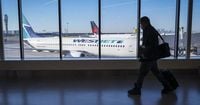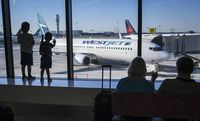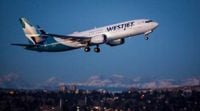WestJet Airlines has announced the suspension of nine routes between Canada and the United States, a decision driven by a notable decline in travel demand among Canadians. This move comes as the airline grapples with the effects of reduced interest in U.S. destinations, a trend that has been exacerbated by ongoing geopolitical tensions and trade-related issues.
Beginning June 1, 2025, WestJet will halt flights from Winnipeg to Los Angeles, a route that has seen declining passenger numbers. According to Kerilee Falloon, spokesperson for the Winnipeg Airports Authority, the suspension is part of a broader trend affecting several flights between Canadian cities and popular U.S. destinations.
In total, the airline is pausing flights on the following routes: Vancouver to Austin from May through October, Calgary to Fort Lauderdale, Edmonton to Chicago, St. John’s to Orlando, and Winnipeg to Orlando for the month of June. Additionally, flights from Kelowna to Seattle-Tacoma and Winnipeg to Los Angeles will be suspended from June through August. Finally, the Edmonton to Atlanta and Winnipeg to Las Vegas routes will be paused from July through August.
The Edmonton-Chicago route is set to return on June 28, 2025, while St. John’s to Orlando will resume on June 30, and Winnipeg to Los Angeles will return on August 28. A spokesperson for WestJet stated, "WestJet continuously evaluates and adjusts its schedule to meet demand, and we remain committed to reviewing opportunities for direct service on these routes in the future." This reflects the airline's ongoing strategy to adapt to changing market conditions.
The decision to suspend these routes comes amidst a backdrop of declining travel demand. Recent statistics reveal a 13.5% decrease in Canadian trips to the United States in March 2025 compared to the same month in 2024. This trend has persisted for several months, marking the third consecutive month of year-over-year declines and the steepest drop since the onset of the COVID-19 pandemic.
According to data from Statistics Canada, the number of Canadians returning home by car from the U.S. fell nearly 32% in the same period. Furthermore, U.S. Customs and Border Protection reported that there were over 910,000 fewer land border crossings from Canada into the U.S. last month than in March 2024, translating to a more than 22% drop.
Analysts suggest that several factors contribute to this declining travel trend, including the ongoing trade tensions with the United States, particularly under the administration of former President Donald Trump. His administration's tariffs and rhetoric, which have included statements suggesting that Canada should be the 51st state, have fostered a climate of uncertainty among Canadian travelers.
In light of these developments, Air Canada has also reported a 10% decrease in flight bookings for routes between Canada and the U.S. for the upcoming summer season. The airline industry as a whole is feeling the pressure as travelers reassess their plans amidst these geopolitical uncertainties.
WestJet's response to this changing landscape includes an expansion of its domestic routes, aimed at facilitating easier connections for Canadians traveling to Europe. This strategic shift indicates the airline's commitment to adapting to current market conditions while exploring new opportunities.
While the suspensions are temporary, they highlight a significant shift in travel behavior among Canadians. With fewer people opting to travel south, the airline industry may need to rethink its strategies to attract travelers back to U.S. destinations.
As the summer travel season approaches, it remains to be seen how these suspensions will impact the airline's overall performance and whether demand will rebound in the coming months. For now, WestJet and other airlines are closely monitoring the situation, ready to make adjustments as necessary.
In conclusion, the suspension of these nine routes is a clear indication of the changing dynamics in cross-border travel, driven by lower demand and external factors affecting Canadian travelers. Whether this trend will continue or reverse in the future is a question that both airlines and travelers will be watching closely.






